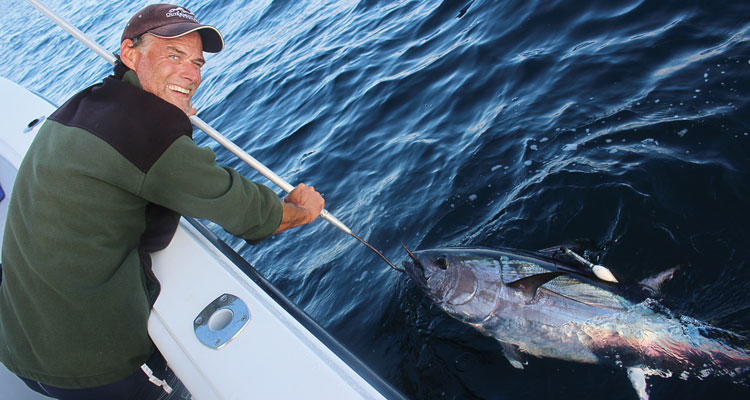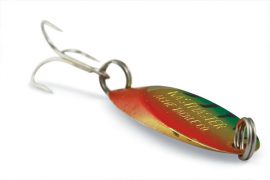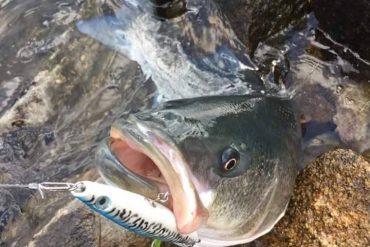
Pictured above: Capt. Josh Zacharias revives a large school-size bluefin prior to release during a memorable August day on which six tags were deployed.
Satellite-tagging provides key insights into light-tackle bluefin tuna post-release survival.
Few saltwater anglers would dispute that tossing a plug or soft-plastic lure into a frothing school of feeding bluefin tuna, or coming tight to one while speed-jigging through the water column, represents one of fishing’s ultimate thrills. After a few pioneering anglers set out to subdue bluefin on spinning gear in the early 2000s, interest in the light-tackle “jigging and popping” fishery has continually grown, and several charter operators now specialize in guiding clients to a pulse-pounding, leg-shaking, involuntary-expletive-spewing encounter. Even among those who primarily target bluefin using more conventional means, arsenals of many anglers who set out offshore from New England to North Carolina frequently include at least a couple of spinning setups in case the opportunity to throw an offering into crashing fish presents itself.

And, it’s a good time to be a light-tackle angler—or any bluefin angler, for that matter. The most recent stock assessments conducted by the International Commission for the Conservation of Atlantic Tunas (ICCAT) suggest that neither the eastern nor western stock of bluefin is experiencing overfishing, and that both populations are rebuilding from their currently overfished states. If the trend continues, the opportunities for anglers to tangle with these incredible fish will continue to increase.
Dramatic improvements in the gear available to the jig-and-pop community have enabled anglers to land bluefin weighing more than 600 pounds on light gear, though the bread-and-butter quarry are fish that fall into the large school (47 to < 59 inches curved fork length [CFL]) and small medium (59 to < 73 inches CFL) size classes. Regulations in recent years have generally allowed anglers to keep one large school- or small medium-size fish per vessel per day, which means that when the bite is on, there can be high numbers of releases. In fact, data from the National Marine Fisheries Service’s Large Pelagics Survey indicate that in recent years, the number of fish released for these size classes has approached or even exceeded the number of fish harvested.

All these fish being let go begs the question: Do bluefin tuna survive after they’ve been caught and released by recreational anglers? Previous studies using pop-up satellite tags have shown high survivability for giant bluefin (weighing 250-1,000 pounds, 57 of 59 fish survived) caught by experienced anglers using 130-pound-class tackle fished out of rod holders with barbless circle hooks off Prince Edward Island, Canada. School-size fish (lengths of 27 to 47 inches CFL, 19 of 19 fish survived) were caught using 50- to 130-pound conventional stand-up gear while trolling off Massachusetts and New Jersey (Stokesbury et al. 2011, Marcek and Graves, 2014). However, post-release survival is known to vary with fish size and by gear type. Bluefin caught on spinning gear may experience greater physiological stress due to long fight times, and may experience physical injuries resulting from treble hooks commonly used on plugs. As a PhD student in the Fisheries Genetics and Pelagic Fishes Program at the Virginia Institute of Marine Science (VIMS), I sought to investigate the post-release survival of light-tackle-caught large school- and small medium-size bluefin, as well as to identify best practices that could maximize the survivability of released fish.
Following the Bite—Day and Night
In many ways, tuna research is similar to tuna fishing: little sleep, less-than-ideal dietary habits, and dropping everything at a moment’s notice (and often driving through the night) to get offshore when the getting is good. My own field work, which involved deploying satellite tags on bluefin tuna off Massachusetts and North Carolina’s Outer Banks, relied heavily on the generosity of charter captains and their clients to allow me on board to tag any fish they released (typically after the one permitted fish per day had already been harvested). I’m especially indebted to Massachusetts Captains Dom Petrarca (Coastal Charters Sportfishing) and Bobby Rice (Reel Deal Fishing Charters), and to North Carolina Captains Ned Ashby (Sea Breeze) and Dan Rooks (Tuna Duck) and their clients for regularly letting me hitch a ride to the grounds, though a large number of captains and anglers contributed to the effort. Tagging—again, like tuna fishing itself—was streaky: We would go several days without hooking a fish, then deploy multiple tags in a single outing. As they say, “You don’t know if you don’t go.”






